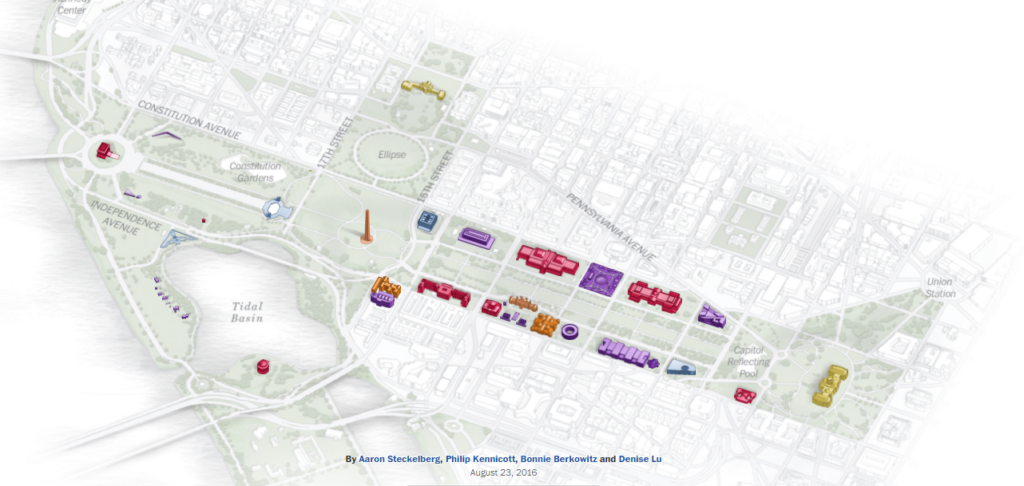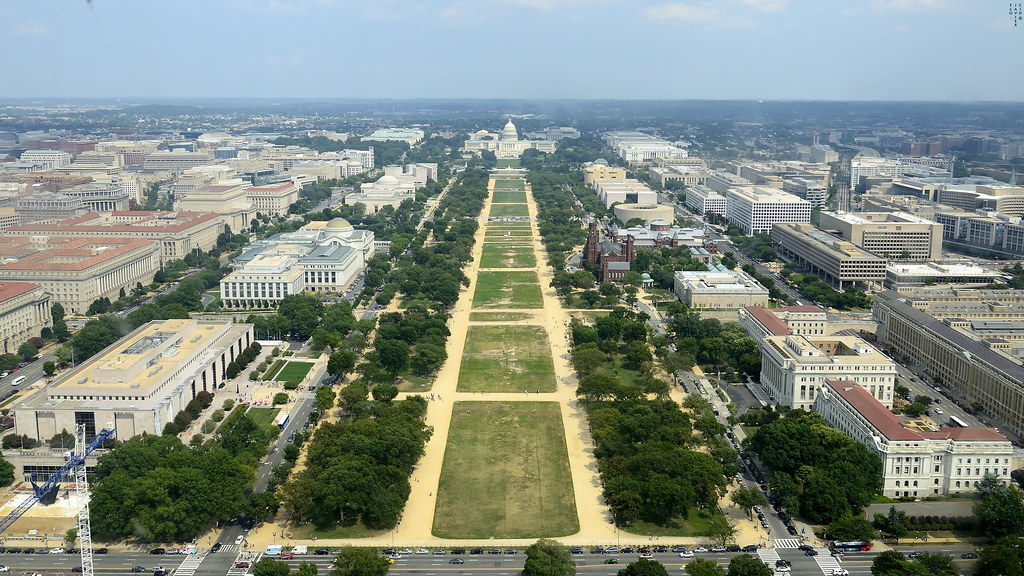Author: Xin Su
Translator: Joyce Zhao
In the National Mall, there are eleven national museums and art galleries. They stand tall, burly and solemn on either side of the National Mall in Washington, D.C. in their own unique style. There are 6 museums and the National Zoo in other places in Washington, D.C. So, can there be an Asian American museum added to the National Mall?
Our dream is for the Asian American Museum to be built on the last vacant lot of the National Mall.

Figure 1. The floor plan of the National Mall of the United States.
On May 22, 2021, the three non-profit organizations Association of Chinese Americans for Social Justice (ACASJ), Asian Pacific Islander American Public Affairs Association (APAPA), and National Council of Chinese Americans (NCCA) together celebrated Asian American and Pacific Islander Heritage month. This event entered the May online lecture series as the fourth lecture. Jay Xu, director and CEO of the Asian Art Museum in San Francisco, was invited to speak on “How to Realize Civic Engagement Through Artistic Channels?” [1]. At the same time, Democratic Representative Grace Meng of New York State also attended the meeting and delivered a speech.
Four days before the lecture, on May 18, the U.S. House of Representatives passed the COVID-19 Hate Crimes Act with an overwhelming advantage, aimed at combating anti-Asian hate crimes under the COVID-19 pandemic. President Biden signed the bill on the 20th. This bill was drafted and initiated by Grace Meng and Democratic U.S. Senator Mazie K. Hirono of Hawaii.
Jay Xu is the first Chinese American to serve as the director, CEO of a large art museum. Previously, he worked at the Metropolitan Museum of Art in New York, the Art Institute of Chicago, and the Seattle Art Museum. The day after the Atlanta shooting on March 16, Jay Xu published an open letter on the website of the Asian Art Museum in San Francisco: “Stop Anti-Asian Violence and Hate.” At the same time, he also urged other institutions in the industry to speak out against Asian hatred. Urged by Jay Xu, the Association of American Art Museum Directors made a public speech on April 1 to oppose discrimination against Asians.
Grace Meng and Jay Xu, two people who had never met before, each spoke for Asians in their respective positions, colliding with a dazzling spark at the May lecture series — the vision of an Asian American museum.
In her speech, Grace Meng emphasized the importance of promoting Asian history education. Grace Meng said, “I want to make sure that Kids in America learn about Asian Americans. I was born and raised here and educated in the United States, but I didn’t learn too much about the Chinese Exclusion Act. I did not learn too much about Japanese internment camps. I did not learn too much about how our community played a role in American history. We are just as Americans as everyone else, but our whole lives even I was born and raised here, we are made to feel that we are outsiders, and we are not truly Americans.”
Then she changed the conversation and said hesitantly, “My last point to bring up to you… I don’t even know if I would see this in my lifetime, I am starting to pass to a bill one day to build an Asian American museum.” Then, she said firmly, “We have an African American museum that is beautiful. We are staring a Latino museum. Hopefully, one day we have a museum about Asian American history in this country as well.”
Grace Meng’s vision aroused strong interest. The host of the lecture, Liu Yawei, said immediately: “You talked about your dream, and it is also our dream to have an Asian American museum in the National Mall. What suggestions do you have for establishing an Asian American museum? What can we do?”.
Grace Meng believes that we must follow the footprints and paths of the African-American museum and the Latino museum, gaining experience from them. The first step is to get the study done and then congress needs to pass legislation for our study. She said, “We did have a hearing last year in house administration committee and we just asked them again this year. Hopefully, we will find out more information soon”. Secondly, she continued, “the Smithsonian museum has an Asian Pacific American Center. I was able to get them some funding in the past two years, and they can carry out many programs for Asian Americans. If everyone sees they have Asian American activities, please support them, even virtually. This helps them to feel that people are interested in these activities.”
From dream to reality, it took more than 100 years for the African American museum to be completed. For more than a hundred years, social activists had been promoting the establishment of an African American museum to commemorate and bring to light the contributions of African Americans. They overcame various obstacles, fierce battles with Congress, and repeated changes to the design plan, but the African American museum finally held a groundbreaking ceremony on February 22, 2012. The museum opened to the public on September 24, 2016. For this day to come, people of several lifetimes have waited for more than 100 years. The United States held a grand “Freedom Sounds” celebration at the Washington Monument on September 23. The grand commemoration lasted for 3 days [2].
At the end of 2020, Congress approved the establishment of two museums dedicated to American Latinos and women in the United States. Senator Bob Menendez (D-NJ) wrote in a statement, “we have overcome tremendous obstacles and unbelievable hurdles to get to this historic moment, but as I’ve said before, Latinos are used to overcoming obstacles.” [3]
The costs of the African American museum and the newly approved American Latino and women’s museum were shared equally between public and private funds. The Smithsonian Museum’s Board of Directors was responsible for finding space for the museum inside or near the National Mall.
Where is the Asian American Museum?
Jay Xu was very excited when he heard Grace Meng’s proposal: “I have devoted 40 years of my life to museums, 30 of which were in the United States. I saw museums for indigenous peoples, for African Americans, and for American Latinos. These are very important,” he said, “so the establishment of an Asian history and culture museum is imperative!”
Jay Xu reflected that it is especially important to have Asian American museums in an iconic place where museums gather like the national museums in Washington, D.C., the capital of the United States.
Jay Xu agrees wholeheartedly with Grace Meng’s statement that we must unite with other ethnic groups and receive broad support. He added that the founder of the African American museum is now the president of the Smithsonian Museum. He has rich experience in the establishment of minority museums and plays a decisive role in the future development of the Smithsonian Museum. We want to cooperate with him.
Jay Xu’s vision is to proudly witness the opening of an Asian American Museum in his lifetime. He said to all the audience attending the lecture, “All of us today will see the opening of the Asian American Museum! This is bound to be another major moment in American history for Asians.“
The establishment of the Asian-Pacific American History Museum is our beautiful vision. The realization of this vision requires everyone’s cooperation to work hard together. We call on all Chinese in the United States to let us work together to build an Asian American museum on the National Mall in Washington, D.C.!
References:
- On May 22, 2021, the three non-profit organizations Association of Chinese Americans For Social Justice, Asian Pacific Islander American Public Affairs Association (APAPA), and National Council of Chinese Americans (NCCA) together celebrated Asian American and Pacific Islander Heritage month. May lecture series video playback: https://www.youtube.com/watch?v=yuDV6zh7O0w
- The African American museum took 100 years to build. https://www.washingtonpost.com/entertainment/museums/timeline-it-took-over-100-years-for-the-african-american-museum-to-become-a-reality/2016/09/20/dc080c54-5a8c-11e6-831d-0324760ca856_story.html
- At the end of 2020, Congress approved the establishment of two museums commemorating the American Latino and women in the United States. https://www.npr.org/2020/12/22/949153631/congress-approves-2-new-museums-honoring-american-latinos-womens-history

I support the Asian American museum and was did not support the Latino, Latinx or Hispanic museum., Those are all governmental labels. We are Spanish speaking indigenous people. No such people as Latinx.